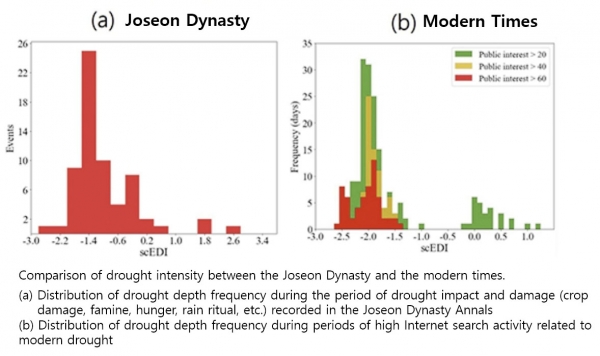
This year, farmers suffered from heat waves under severe drought in South Korea. During the Joseon Dynasty, the agriculture industry was centered on rice farming, which made society more vulnerable to droughts or floods. Thus, our ancestors made great efforts to predict the weather in order to minimize agricultural losses.
Professor Jonghun Kam and Dr. Park Chang-Kyun in the Department of Environmental Science and Engineering developed a “self-calibrating Effective Drought Index (scEDI)” and compared and analyzed precipitation records for about 250 years from the Joseon Dynasty to the modern era.
The Effective Drought Index (EDI), which is used to determine the intensity of the drought, measures daily drought conditions. Since EDI uses the daily precipitation record of the last 30 years as a climatological period, the value of the EDI cannot be extrapolated to previous centuries for historical droughts over the centuries.
Prof. Kam’s research team first proposed scEDI and analyzed the daily precipitation observed in Seoul from 1777 to 2020. The scEDI uses time-varying climatology over time, so it can consistently evaluate the frequency and intensity of historical droughts.
Based on the drought records from Joseon Dynasty Annals and current online information search activity data, the reports of drought from the Joseon Dynasty Annals and the surge of interest in drought from NAVER DataLab was found during moderate (-1.4 of scEDI) and severe (-2.0 of scEDI) droughts, respectively.
This result indicates a possible time-varying effect of drought on our society and socioeconomic structure changes. This index, which can quantitatively evaluate the effects of drought, is expected to be used as a tool to identify social droughts in the future preemptively.
Prof. Kam said, “The scEDI is a climate-tailored drought index for each era, and it is possible to detect and compare statistically consistent characteristics of drought. This suggests a new research methodology for studying the social effects of droughts, which enables us to investigate the linkage between the physical characteristics of historical droughts and associated social responses and patterns. We expect that scEDI will provide ways for the Korean public to prepare for future droughts by better understanding the social impact and response patterns during historical droughts.”


